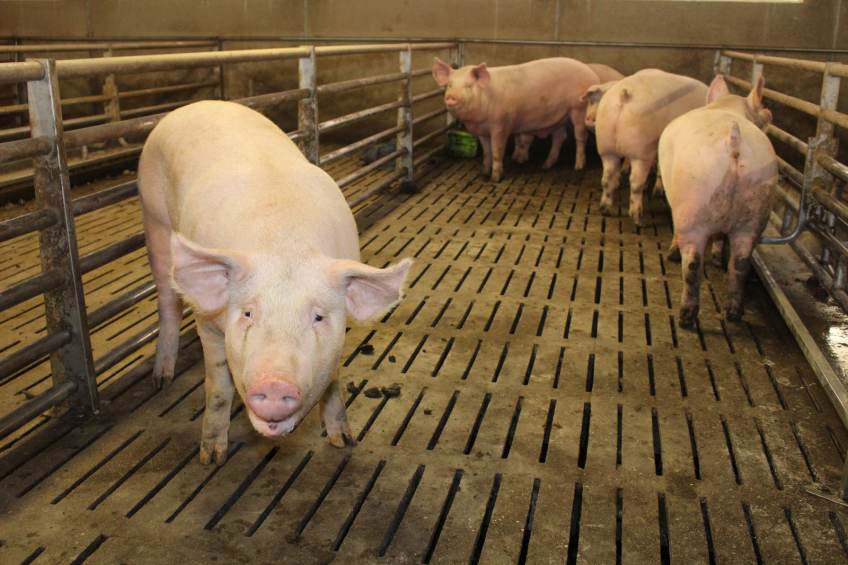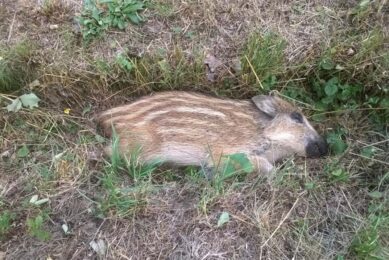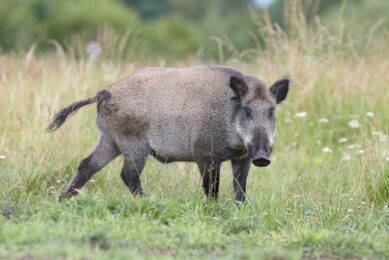High biosecurity for Europe’s largest finishers

There will not be many farms keeping finishers up until around 220 kg. The farm of the Chiozzi brothers near Cremona, Italy, is an exception in this respect. The facility offers many interesting features – e.g. the constant striving for a high health status.
Emanuele Chiozzi is a perfectionist. His visitors already wear protective plastic layers, but he asks them to wear one extra disposable boot on top. Look, he explains, while standing in the door opening of the gestation house, lift your foot up, add the plastic boot and put down your foot over the threshold inside the barn.
Chiozzi Farm, Italy
Type of farm: Farrow-to-finish; heavy pig production
Number of sows: 240
Pigs weaned/sow/year: 26.50 (2012)
Pathogens present: PRRSv, P. multocida, S. suis, H. parasuis and E. coli.
Average daily gain (30-170 kg): 780 g.
The full name of the facility is Chiozzi Francesco, Danio ed Emanuele – as the name suggests, Emanuele Chiozzi, 34, owns the facility together with his brothers. The farm has been in existence for 17 years, and has grown to be a closed farrow-to-finish pig farm near Cappella Cantone, a small town north west of Cremona, Italy.
The Chiozzi brothers. From left to right: Emanuele, Francesco and Danio Chiozzi.
The farm focuses on the production of heavy pigs, the majority destined for Parma ham production. Of the three brothers, Emanuele is most to be found on the farm, being in charge of pig production – ‘living there’ as he calls it himself. His brother Danio is helping out on the farm, but is mostly involved in purchasing feed raw materials and trading pigs, while Francesco is in charge of their own slaughterhouse and sales of pork meat and products – more about this in the box ‘A slaughterhouse of its own’.
A slaughterhouse of their own
Not every pig at Chiozzi farm gets to grow up until 220 kg (485 lbs). Only about 10% of the finest animals can live until that age. These get special treatment and will be slaughtered in the Chiozzi’s own slaughterhouse, where the pigs after about 12 months will be slaughtered manually. Two products are particularly notable from this facility, one being the salame cremonese (pictured) – it is emphasised that this is different from conventional salami. The product contains lean and fat parts in the minced meat to which salt, spices and pepper are added, after which it is left to mature, absorbing all the flavours. Only the best parts of the pigs, most notably from the back are being used for this product. In addition, the heart of the famous Italian hams is being sold as culatello, a specialty product for the region. On Friday and Saturday, the own spaccio (shop) opens, allowing customers to purchase directly from the farm. The remaining 90% of the pigs qualify for Parma ham production and are sold at approximately 170 kg (375 lbs) liveweight.
Profound mentality change needed in Italy’s pig industry
Where many pig producers in Italy still have to go through a profound change in mentality with regard to e.g. biosecurity, Emanuele Chiozzi doesn’t need any round of explanation whatsoever. Instead, he almost makes it a sport to produce as naturally and biosecure as possible – after all, every pathogen that can be kept out of the farm premises doesn’t have to be combatted.
This awareness grew rapidly when in 2000 the farm was struck by Porcine Reproductive and Respiratory Syndrome (PRRS) virus, he explains. The consequences were so devastating that the Chiozzi family decided to do things radically differently.
- When moving the farm to a completely new site, a new lay-out was decided on, with a biosecurity philosophy at heart. This meant e.g. a physical separation of farrowing, gestating and finishing pigs.
- A clear division was made between ‘inside’ and ‘outside’. A wall encircles the property and trucks were no longer allowed to enter the facility. They stop in front of the buildings, and discharge their products or pick up the pigs outside the farm walls.
- Completely new breeding stock were introduced – and it’s been a closed herd since then, using PIC C26 sows. The only genetics entering the farm is from a terminal sire – Duroc genetics.
- The herd is managed in a three-week system, with all spaces being periodically washed and sanitised.
- Personal hygiene standards are high, with adequate clothing for every building. In addition, external people are very rarely admitted.
Emanuele Chiozzi provides paper snippets to the sows as distraction material.
As few antibiotics as possible used
Emanuele says, “We aim to use as few antibiotics as possible,” adding that numbers on the farm are among the lowest on farms in Italy. “Only when it is really necessary do we mix antibiotics through the feed.” Known bacterial pathogens on the farm include P. multocida, S. suis, H. parasuis and E. coli, the last to a limited extent in the farrowing rooms. Up until two years ago, the farm achieved a respectable 30.55 piglets born/sow/year – a result of an average of 13 piglets born alive per litter, Emanuele says with pride. Post-weaning mortality was also good, with just 1% in grower pigs and 1% in finisher pigs.
For a long time, the approach worked to the brothers’ full satisfaction. From the beginning of 2013, however, the number of piglets born alive started to drop to around 12. The reason? Indeed, a fairly aggressive PRRS strain had returned. Control over PRRS thus proved to be difficult in the heart of the pig area of Italy – imagine the farm being surrounded by six other pig facilities within a 2 km radius around the farm. Despite sows being vaccinated, the farm achieved volatile production figures over the last two years. The average number of piglets weaned per litter was about ten with post-weaning mortality figures being inconsistent.
The farm therefore decided to embark on trials with the Belgian animal nutrition company Bivit, to figure out whether a specialty diet could help boost the immunity of newly weaned piglets. The Belgian company’s ‘Stress Support Pack’ includes specific ingredients that help the animal build up its own immunity and minimise reactions to infections. In addition, complementary anti-oxidants have to reduce the effects of free radicals in the pigs’ bodies. The aim is to reduce mortality and enhance their health status during the duration of the trial, which is three weeks each. The first results of the trial look optimistic.
Several characteristics of the farm include:
Farrowing & growing house
The farrowing barn is made up of two rooms with space for 33 sows each. The piglets are kept with their mothers until they reach 26 or 27 days, when they have an average weight of 8.3 kg (18 lbs). In total, a round of farrowing takes six weeks. The sows are being brought in one week prior to farrowing; lactation for just under four weeks, and cleaning also takes about a week.
The Chiozzi brothers equip the farrowing crates with paper snippets, which serve a twofold function. On one hand, the sows have distraction material prior to farrowing, on the other, the neonatal piglets can use it to get dry quickly after birth. The snippets disappear over time through the slats.
Like the vast majority of pigs on the farm, the sows are being given a liquid diet. The sows receive a mixture of maize, barley, soy and wheat bran. The only pigs not receiving liquid feed are the neonatal ones, which receive small portions of creep feed to get into the habit of consuming a different diet than sow milk.
After weaning, the piglets are brought to a weaner section located in the same building. They are kept in three batches of different age groups, each consisting of about 350 pigs. They receive liquid feed and stay here until they are 25 kg (55 lbs).
One group of weaned piglets, which was fed the Bivit Stress Support Pack.
Gestating sow house
Simultaneously, the sows leave the house to cross a yard through a corridor to the gestating sow area, with a capacity for 200 sows. They are kept in insemination rooms for about 28 days. In accordance with EU legislation, the gestating sows are being kept in group housing, with about six animals per pen. They receive liquid feeding, served in long troughs at the walls. The pens are also equipped with distraction material, in this case empty jerry cans. The sows stay here for about 80 days until one week before farrowing.
Jerry cans are provided as distraction material to sows in group housing.
Finishing pig house
The road from 25 to 170 kg (55-375 lbs) is divided into two stages. There are four groups of magroni, the best translation could be ‘growers’ – pigs between 25 and 70 kg (55-154 lbs). In addition, there are seven groups of ‘larger finishers’, for pigs that are between 70 and 170 kg (154-375 lbs). All receive liquid feed, with diets gradually changing as age and weight change. For instance, all pigs heavier than 40 kg (88 lbs) receive a diet containing by-products from Gran Padano cheese production. In addition, temperature management changes the older the animals get.
At 160-170 kg (353-375 lbs), when the pigs are about nine months of age, the pigs get sent for slaughter as it is the ideal weight and age for Parma ham production. The remainder of the carcasses usually end up in regular production.
About 10% of the pigs, however, will get to live up to about 12 months – and about 220 kg (485 lbs). They will not be sold but slaughtered in the Chiozzi farm’s own slaughterhouse, see box.
Finisher pigs at their trough filled with liquid feed.
Economic situation
Pig farming in Italy hasn’t been exactly a walk in the park lately, Emanuele Chiozzi explains. Prices for pigs were reasonable in the spring of 2014, but prices for raw materials have continued to be high for a long time. Emanuele Chiozzi explains, “We are dependent on the market for purchasing a lot of feed. We don’t have that much land, and can only produce 5% of what we feed the pigs. In addition, heavy pigs are very low in feed conversion rates.”
Still, the Chiozzi farm is in business unlike various other farms. Emanuele Chiozzi directly relates that to the management switch that was taken in 2000. He says, “For instance, we have also had solar panels fitted on the roofs, which helps reduce the energy bill. I’m confident that our mentality change helped us to improve our way of working.”
Travel around the world from pig farm to pig farm with Pig Progress as your guide. Click on your desired destination and sit back and enjoy the journey.
[Source: Pig Progress no. 9 – 2014]
Join 18,000+ subscribers
Subscribe to our newsletter to stay updated about all the need-to-know content in the pigsector, three times a week. Beheer
Beheer










 WP Admin
WP Admin  Bewerk bericht
Bewerk bericht